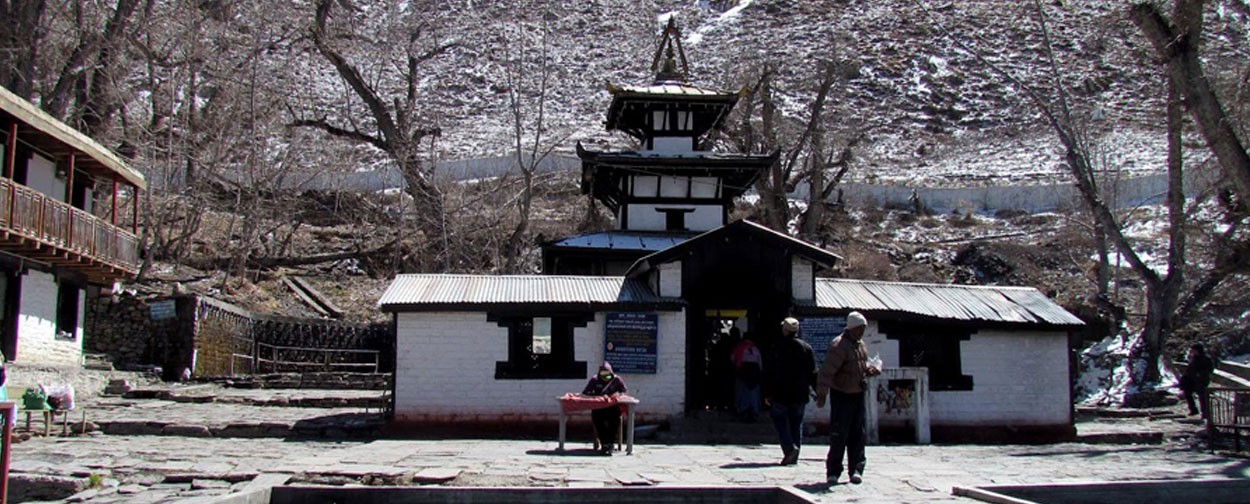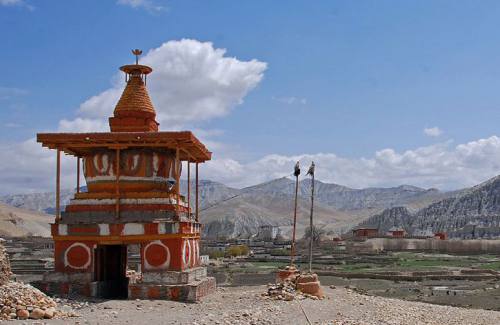Jomsom and Muktinath Trek
-
Trip Duration 14 Days
Trip Facts
- Destination:Nepal
- Trip Grade:Moderate
The trail passes through the deepest gorge of Kali Gandaki to the arid desert like landscape of the Tibetan Plateau, followed by a spectacular mountain flight to pokhara from Jomsom between the massiff of Dhaulagiri and Annapurna.
The Jomsom trek is probably the single most popular trek in Nepal. The diverse landscapes and cultures found along the trek route give a marvellous insight into the way of life of rural Nepalese people. The main feature of the trek is the walk though the forge carved by the Kali Gandaki River, which carries water from the Tibetan plateau to eventually join the Ganges in India.
Normally trekkers continue above Jomsom to Muktinath, the famous pilgrimage site for both Buddhists and Hindus. To the Hindu, Muktinath is scared as the place of salvation. They believe that to wash in the waters here guarantees salvation after death. The Hindu god, Brahma, is thought to have lit the eternal flames that still burn at Muktinath. To the Buddhists it is a place that the great sage Guru Rinpoche (Padmasambhava) meditated at, and to all, it is the source of fossilised ammonites, known locally as shaligrams that are found all along the upper reached of the Kali Gandaki.
The people of this part of Nepal are a mixture of Gurung and Magar in the lower stretches of the Kali Gandaki, Thakali People around Jomsom and people with obvious Tibetan roots, the Lopa, around Muktinath and up into Mustang. Their customs and dress are all quite distinct and this trek gives a chance to see those differences. The religions seen ranges from Hinduism in the lower part to Tibetan style Buddhism as you travel further north. Should you be in Muktinath in early September you will be able to see one of Nepal’s unique festival, the annual horse races known as Yartung. This is a week of some serious horse racing, Tibetan style, and some equally serious merrymaking.
Most of the route for the Jomsom trek has been described as part of the Annapurna Circuit and Annapurna Foothills trek. The normal starting point is Naya Pul on the Pokhara to Baglung road and from there, via Ghorepani and Tatopani, into the gorge of the Kali Gandaki.
Between Tatopani and Lete Khola the scenery changes dramatically. Pine forests crowd in on the trail and the villages take on a quite different appearance. The layout of the village and the design of the houses are both quite unique to this area. They are designed to protect their inhabitants form the strong winds that blow up the valley every day from late morning onwards. These winds are caused by differences in atmospheric pressure between the Tibetan plateau and the lower reaches of the valley. The best example of this unique architecture is to be found at the village of Marpha, which is a two-hour walk below Jomsom. The stone flagged streets with an efficient underground drainage system and the flat roofed houses all with a central courtyard make an attractive spot to spend an extra rest day. Sample the apple products that abound around here, all produced from the prolific orchards that have been set up in the valley.
Jomsom is best known for its airport that offers a quick entry or exit to the valley with regular daily flights from Pokhara. Remember that the winds that blow up the valley normally mean that no flights can arrive or depart from Jomsom after 11 am. Jomsom can also be considered as a place to use as a base for exploring the upper part of the Kali Gandaki. There are numerous accommodation options including a new high-class resort complex.
An alternative to Jomsom as a final base for the trek is the village of Kagbeni, a further two hours up the valley. Kagbeni is much less commercialised than Jomsom and certainly much quieter. This is as far as trekkers are allowed to go towards Upper Mustang without having a special trek permit and an accompanying environmental officer. From Kagbeni to Muktinath takes three to four hours and trekkers can choose to do this as a day trip for to stay at one of the many teahouses available at Muktinath.
Day
1Arrival in Kathmandu 1300m/4264ft
Welcome to Nepal! A friendly representative from Purple Journeys will meet-and-greet you at the arrival area of the Tribhuvan International Airport with a flower garland – a tradition gesture of Nepalese hospitality. You will then be ushered to your pre-booked hotel. Unwind from your flight and meet us in the evening at a traditional Nepalese restaurant for a fine meal accompanied by folk music and a cultural program.
2Kathmandu Sightseeing and trip prepration
Explore the cultural treasures of Kathmandu in our guided tour and immerse yourself in the vibrant array of bustling streets, incomparable historic buildings and heritage, exquisite temples and religious sites. The tour includes the holiest Hindu pilgrimage site of Pashupatinath Temple, the colossal stupa of Bouddhanath, Swoyambhunath Stupa also known as The Monkey Temple and the historic Kathmandu Durbar Square with ‘Kumari Ghar’. There will also be time for shopping, picking up a thing or two for your trekking, if you have not done it back home. In the evening, we will have a pre-trek discussion and familiarize with our leader, other crew and participants.
3Drive from Kathmandu to Pokhara 823m/2700ft: 6 hours drive
We’ll depart Kathmandu this morning by private van or bus for Pokhara. The scenic drive will take us through scenic countryside to the famous lakeside city where we can relax for the evening and savor the spectacular mountain views over Phewa Lake.
4Drive to Nayapul and trek to Tikhedunga 1552m/5090ft: 1 hour drive and 4 – 5 hours walk
Depart from Pokhara after breakfast to Nayapul, the starting point of our trek. Following the north side of the BurungdiKhola, we ascend through forests and farmlands. We cross the ModiKhola over a suspension bridge and ascend to Tikhedunga.
5Trek from Tikhedunga to Ghorepani 2750m/9020ft: 6 – 7 hours walk
Crossing another bridge over the BurungdiKhola, we ascend a steep hillside trail comprised of over a thousand stone steps to Ulleri. After a well-deserved rest and enjoying the view, we continue on for another short climb to our overnight stop in Ghorepani.
6Trek from Ghorepani to Tatopani 1190m/3904ft: 5 – 6 hours walk
Ascending out of Ghorepani, we’ll enjoy great views of Annapurna south and Nilgiri. After a steep descent to Sikha and then Ghar Khola, followed by another river crossing and ascent we’ll arrive in Tatopani. Relax your tired muscles in the hot springs nearby.
7Trek from Tatopani to Ghasa 2110m/6922ft: 5 – 6 hours walk
The trail to Ghasa winds through a deep gorge between the soaring peaks of Annapurna and Dhaulagiri, providing for amazing scenery as we make our gradual ascent. We’ll pass a notable waterfall called RupseChahara and several villages before reaching Ghasa.
8Trek from Ghasa to Marpha 2680m/8792ft: 4 – 5 hours walk
Beginning with a steep climb through dense forests of rhododendron, oak, and bamboo, we pass through Lete and on to the Kali Gandaki’s eastern bank. After stopping to rest in Larjung, we continue into Nepal’s apple producing region as we approach Marpha.
9Trek from Marpha to Kagbeni 2810m/9218ft: 4 – 5 hours walk
Enjoy some of Marpha’s famous apple brandy or a slice of pie before departing Marpha today. We cross over a ridge to Jomsom and descend to the riverbed, where we follow the trail onwards to EkleBhatti. Our day ends in Kagbeni, an ancient village situated at the confluence of two rivers, which served as a transit point in the Himalayan salt trade route to Tibet.
10Trek from Kagbeni to Muktinath 3710m/12170ft: 5 – 6 hours walk
From the banks of the Kali Gandaki, we ascend along a steep trail via Khingar to Jarkot. The desert landscape here, akin to the Tibetan plateau, is in stark contrast to the verdant hillsides from which we have come. Today’s final ascent will bring us to Muktinath, a most sacred site of pilgrimage for both Buddhists and Hindus.
11Trek from Muktinath to Jomsom 2715m/8910ft: 5 – 6 hours walk
This morning we’ll visit the temple of Vishnu in Muktinath, with its 108 sacred water spouts whose waters are said to cleanse the souls of those who bathe in them. Also visit the Buddhist monastery and enjoy spectacular views of Dhaulagiri. From Muktinath, we descend to Jomsom, the last stop on our journey.
12Fly from Jomsom to Pokhara: 30 minutes flight
We depart in the morning for an amazingly scenic flight to Pokhara between the Annapurna and Dhaulagiri massifs. Arrive in Pokhara in the afternoon and enjoy the evening relaxing by Fewa Lake.
13Drive from Pokhara to Kathmandu: 6 hours
Depart by private van or bus this morning for Kathmandu. Spend the evening in Thamel reminiscing after an amazing journey.
14Depart Kathmandu
Take care of any last minute shopping or sightseeing as time permits. You’ll be picked up at your hotel three hours prior to your departure flight. Thanks for traveling with Purple Journeys. Farewell and Namaste.
WHAT'S INCLUDED
- Airport pickup and drop off in private vehicle
- Hotel with included breakfast in Kathmandu and Pokhara
- Private transportation and government licensed guide while sightseeing in Kathmandu and Pokhara valley
- Entrance fees for attractions (UNESCO world heritage sites, museums, etc.) during sightseeing in Kathmandu and Pokhara
- Government licensed, experienced trekking guide and porters during trekking
- Insurance for trekking crew (guides and porters)
- Accommodations in tea-houses during trekking
- Three daily meals while trekking
- All required conservation fees and trekking permits (TIMS)
- Air ticket to and from Nepal from your point of origin
- Visa fee for entry into Nepal
- Lunch and dinner while in Kathmandu and Pokhara
- Personal insurance or cost of air rescue in the event of emergency
- Personal expenses (souvenirs, alcoholic beverages, hygiene items, staff tips, etc.)
SIMILAR PACKAGES
You may also like these tripsAFFILIATIONS







